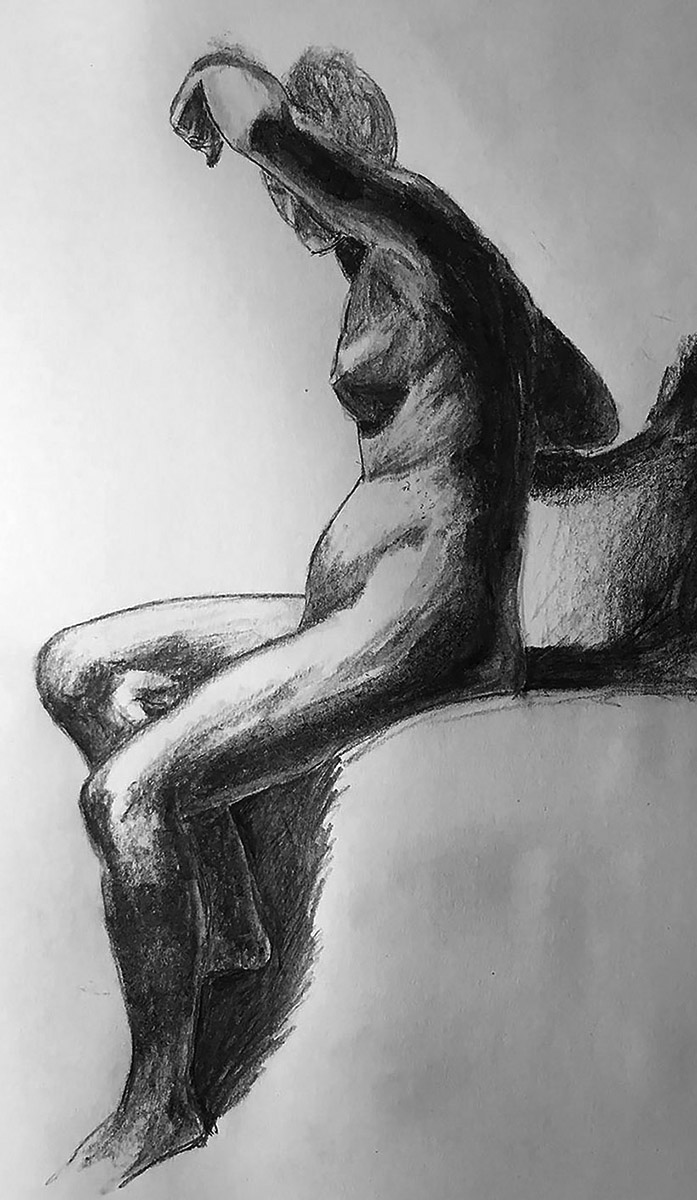
Next up on our Old Master copy marathon we have a graphite drawing after the talented draughtsman Pierre Paul Prud’hon. His drawing was done in black and white chalk. I never cared for the ‘scratchiness’ of chalk so I opted for pencils of varying darkness. The original work is 22 inches x 15 inches and mine is 12 inches x 9 inches. In fact all the old master copies I did were on 12×9 inch paper. Just in case you’re taking notes. Oh course I really only take up about 8×10 inches of the paper. Speaking of measurements, when I was growing up, teachers taught us the metric system and told us we will eventually transfer to it. Of course, they never set a date when that might occur so I guess technically they were not wrong. Enough of the tech talk, let’s talk about Pierre Paul Prud’hon.
Prud’hon was born on April 4, 1758 in Cluny, France. Which is about a 4 hour drive south from Paris. If you were walking it would take about 75 hours. So if your in Paris and want to visit Cluny, I recommend taking a car. I would make a great travel writer. I’ve never even been to Cluny, but I write about like a true native. Anyway, Pierre-Paul Prud’hon was a painter and draftsman who worked between the Neoclassical style which borrowed heavily from Ancient societies, and the Romanticism which embraced a more expressive, personal style. Prud’hon trained in Dijon, France then moved to Rome and became influenced by the work of Neoclassical artists such as the sculpture Antonio Canova and Jacques-Louis David. He made a living by painting portraits and drawing for engravers. When Napoleon Bonaparte discovered his talent, he was employed received some commissions as a decorator and portrait painter for the court. However, Prud’hon gained reputation from his allegorical paintings. Today he is admired more for his exquisite drawings.
And now for the Spanish translation courtesy of Google Translate:
A continuación, en nuestro maratón de copias de Old Master, tenemos un dibujo en grafito del talentoso dibujante Pierre Paul Prud’hon. Su dibujo fue realizado con tiza en blanco y negro. Nunca me preocupé por el “raspado” de la tiza, así que opté por lápices de diferente oscuridad. El trabajo original es de 22 pulgadas x 15 pulgadas y el mío es de 12 pulgadas x 9 pulgadas. De hecho, todas las copias maestras antiguas que hice fueron en papel de 12×9 pulgadas. Por si acaso estás tomando notas. Oh, por supuesto que en realidad solo ocupo unas 8 x 10 pulgadas del papel. Hablando de medidas, cuando yo era pequeño, los profesores nos enseñaron el sistema métrico y nos dijeron que eventualmente nos transferiremos a él. Por supuesto, nunca fijaron una fecha en la que eso podría ocurrir, así que supongo que técnicamente no se equivocaron. Basta de charlas sobre tecnología, hablemos de Pierre Paul Prud’hon. Prud’hon nació el 4 de abril de 1758 en Cluny, Francia. Que está a unas 4 horas en coche al sur de París. Si estuvieras caminando, tardarías unas 75 horas. Así que si estás en París y quieres visitar Cluny, te recomiendo que cojas un coche. Sería un gran escritor de viajes. Ni siquiera he estado en Cluny, pero escribo como un verdadero nativo. De todos modos, Pierre-Paul Prud’hon fue un pintor y dibujante que trabajó entre el estilo neoclásico, que tomó prestado en gran medida de las sociedades antiguas, y el romanticismo, que adoptó un estilo más expresivo y personal. Prud’hon se formó en Dijon, Francia, luego se mudó a Roma y recibió la influencia del trabajo de artistas neoclásicos como la escultura Antonio Canova y Jacques-Louis David. Se ganaba la vida pintando retratos y dibujando para grabadores. Cuando Napoleón Bonaparte descubrió su talento, lo contrataron recibió algunos encargos como decorador y retratista de la corte. Sin embargo, Prud’hon ganó reputación por sus pinturas alegóricas. Hoy es más admirado por sus exquisitos dibujos.
